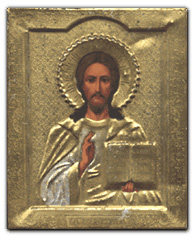The Russian world: icons and ornament
 The conflict between the West and Islam presents Russia with the difficult problem of defining its place in the world. Is Russia a combatant or a peacekeeper? Can Russia maintain a peaceful dialogue with the East?
The conflict between the West and Islam presents Russia with the difficult problem of defining its place in the world. Is Russia a combatant or a peacekeeper? Can Russia maintain a peaceful dialogue with the East?

Russia's history provides us many answers to these questions.
The geographical proximity of Russia to Central Asia gave rise to fierce battles with the Golden Horde.
The Russians were initially impressed by the weapons-chain mail, bows, arrows and small swords-of the invaders and then ... by religious tolerance. When the Tatar-Mongols began their two-century rule of Russia in the beginning of the 14th century, they touched neither churches, nor monasteries. Although the Horde had converted to Islam by the end of its dominance over Russia, this "encounter with the East" became a lesson of military ferocity and humane attitude to the faith and culture of the conquered country.
After the collapse of the Golden Horde, Russia followed their example when it began its conquest of the East, first against Kazan, then against Turkey and the Caucasus, and finally against Central Asia.
Millions of Muslims became subjects of the Russian Empire, however, they were not forced to convert to Christianity. Catherine the Great, who ordered the Koran printed in Arabic, encouraged this. This was an effective move by Catherine the Great, given her wars against Turkey.
Russian icons and oriental patterns are still at odds. The Koran forbids the use of any images of God who, according to the Muslims, is faceless and incomprehensible. Therefore, Muslims believe that depicting God as an old man in heaven or a young man on a cross is ridiculous and naive. Only the ornamental script from the divine word can give a Muslim a hint on the heavenly spirit of Allah. Nevertheless, Russian culture, which has Muslim influences, is the bridge between Islam and Russia.
Pushkin was the first to introduce the East to the Russian reader: the East influenced his poem "Ruslan and Lyudmila". Pushkin began the trend of incorporating the East into Russian literature. Later the Muslim Crimea, Caucasus and other orient elements infiltrated Russian poetry. Through out the 19th century this trend continued with Lermontov and Gogol's arabesques and Leo Tolstoy's Caucasian prose. In the 20th century, Nikolai Gumilev sought his own Orient in Muslim Africa.
Tent-like churches reminiscent of nomads' dwellings emerged in Russia through the Horde's influence. At the end of the 19th century, many Moscow buildings had Oriental-like patterns. Vrubel's best paintings feature formidable and handsome Eastern demons. Islamic images have penetrated Russian households, Dyagileff's ballets, journals' illustrations and, most spectacularly, Russian music. Rimsky-Korsakoff's "Shahrasade", "Prince Igor" by Borodin and Balakirev's melodies are all examples of this. In the 20th century, Stravinsky also incorporated Eastern elements into his music.
Today, Russian culture is still heavily influenced by the Orient. Perhaps, the most glamorous example of this is the writer Timur Zulfikarov. Zulfikarov has been nominated for the Nobel Prize in Literature. This prize could become a highlight in the life of Russia and the Muslim world. The Russian language lacks the austerity of iconography - it is powerful, intricate and unfettered, with enough energy to convey Islamic vigour and enough refinement to convey the fine patterns of different moods.
Even the war in Chechnya has inspired some Russians to create several important pieces of art: Balobanov's film "The War" and Valery Zolotukhin's film "The Muslim". In this work (and the book it is based on), the war is used to depict the missions of the Orthodox people and Muslims. This mission is harmony, life in the name of creation, and the ornamental silver setting around Our Lady on an icon.
Anatoly Korolyov, RIAN
Subscribe to Pravda.Ru Telegram channel, Facebook, RSS!





